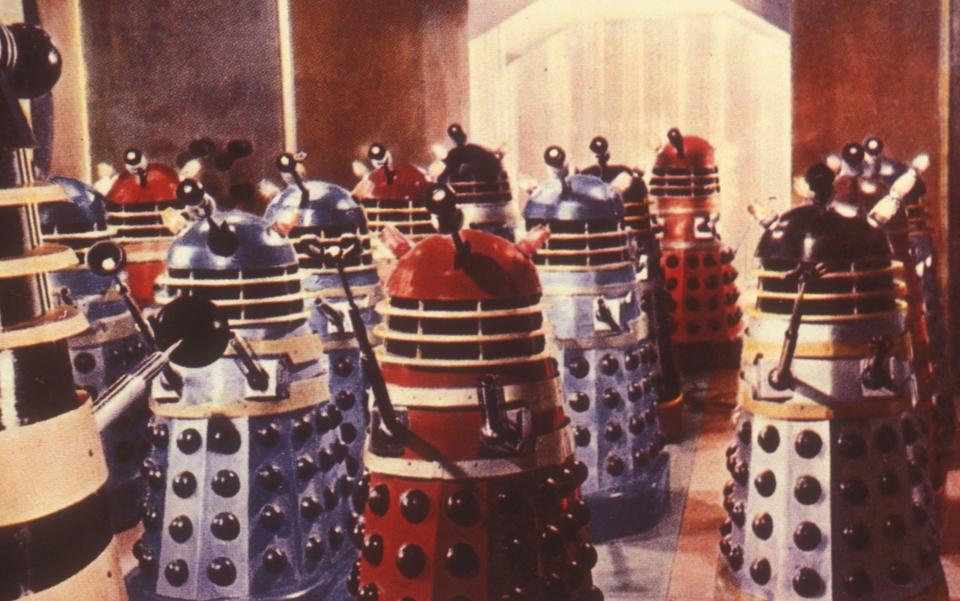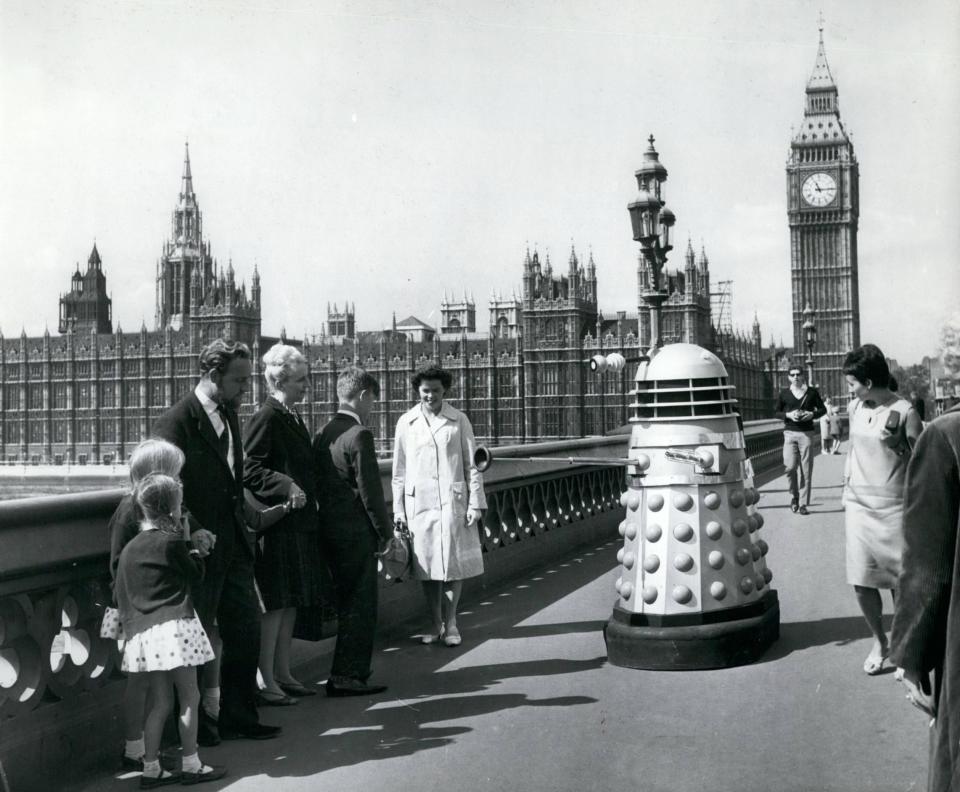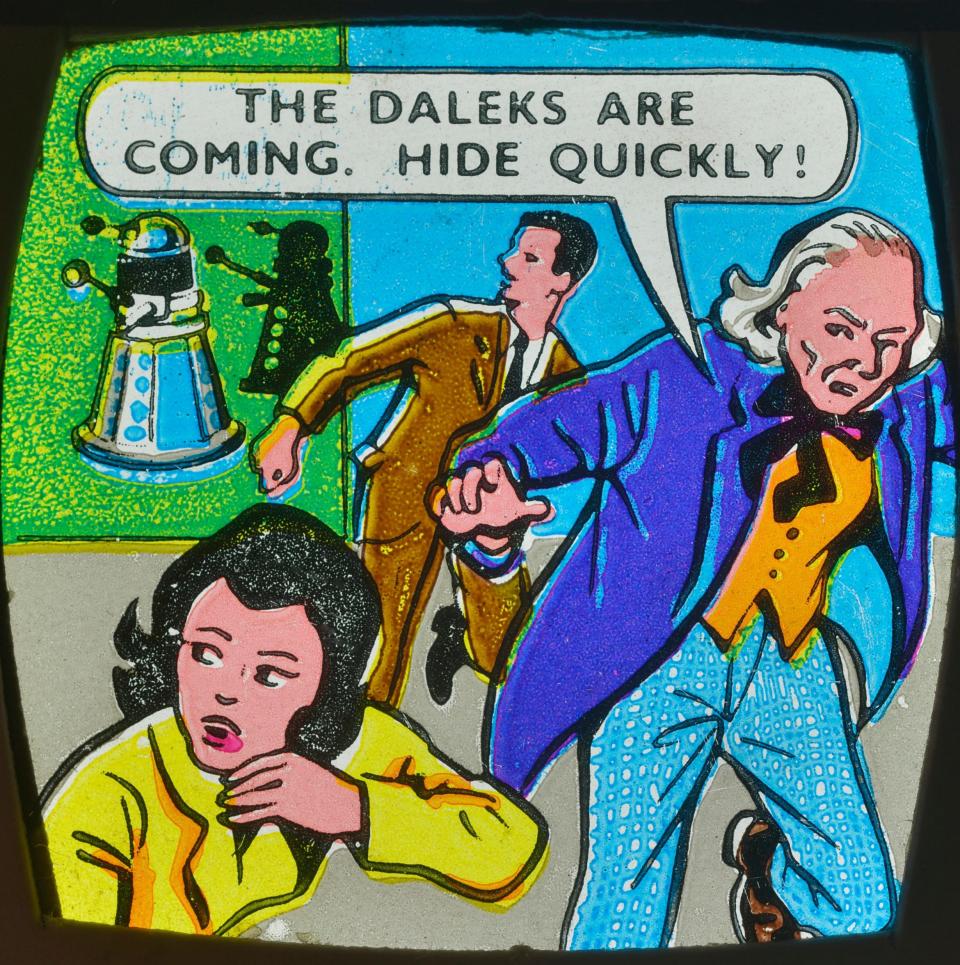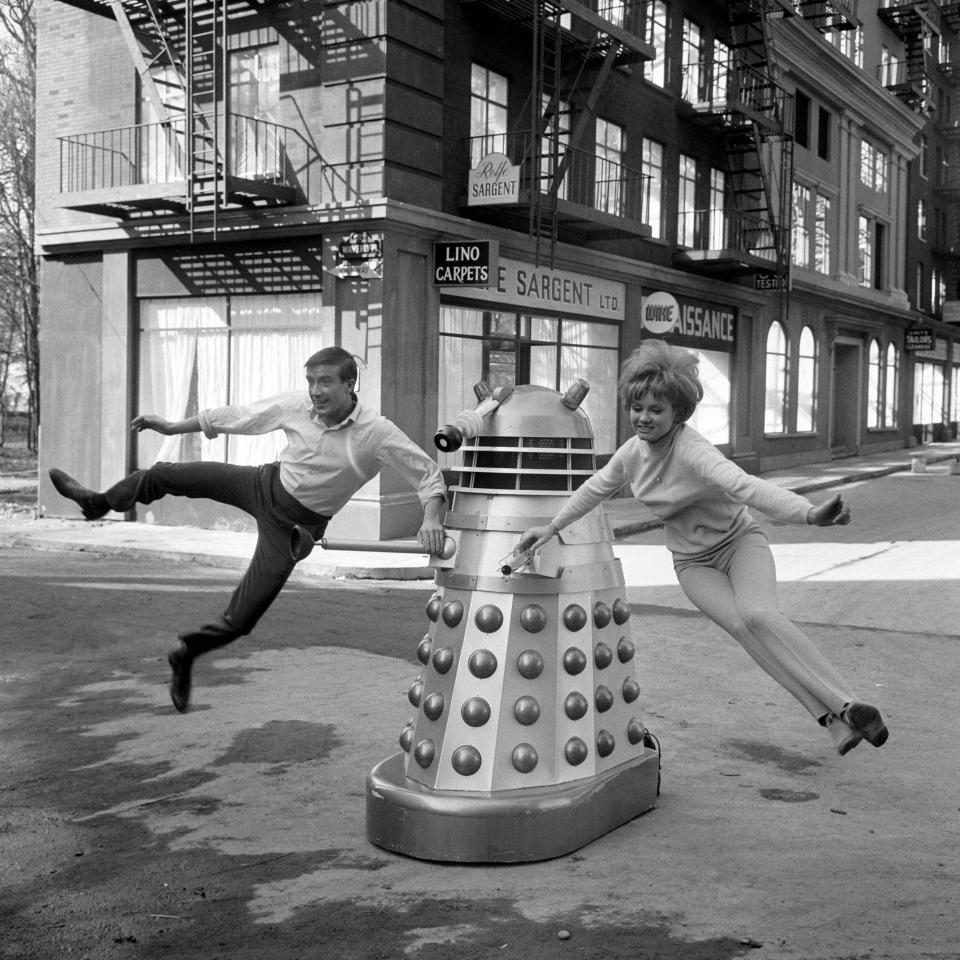The rise of Dalekmania, the Doctor Who craze that made suckers of us all

On May 18 1965, Michael B Bromhead – the general manager of Lion International Films – wrote to producer-screenwriter Milton Subotsky about their upcoming film, Dr Who & The Daleks. In the letter, now kept in the Subotsky Archives, Bromhead advised Milton Subotsky against entering Dr Who & The Daleks into a science fiction festival.
Lion International Films, which distributed the picture in overseas territories, didn’t want to alienate potential viewers by lumbering the movie with a sci-fi label (“which would bring it into a lower category and price bracket,” wrote Bromhead). Instead, they wanted to sell their Who spin-off as a “‘Swiss Family Robison’ type of film, with action, adventure and colour and the additional gimmick of the Daleks.”
Dr Who & The Daleks remains an anomaly in Who history: not proper Doctor Who but a blip in vast wibbly-wobbliness of the space-time continuum. It’s not William Hartnell as The Doctor – that crotchety, alien mischief-maker – but horror stalwart Peter Cushing as a human Dr Who, a kindly old chap who leads his granddaughters and a pratfalling Roy Castle on a bright, bold adventure in both Technicolor and Techniscope.
It hardly mattered that Cushing wasn’t the proper Doctor. The real stars were the Daleks, then so popular that they’d exterminated their way to creating one of the essential crazes of the Swinging Sixties: Dalekmania.
Indeed, Bromhead’s letter was about his excitement at executing their Dalek masterplan-cum-publicity stunt: to send a dozen Daleks to Cannes Film Festival, where the Daleks would parade around the arthouse crowd and get their photograph taken with John Lennon. Just days later they were at the Variety Club Star Gala, hobnobbing with celebrities and helping judge a beauty contest.
“This is an ideal opportunity for an event of this nature which will reach a great number of important distributors from all parts of the world,” wrote Bromhead, “and should of course provide journalists with something really out of the ordinary to write about in their papers. Cannes is the one festival where one can really get away with this type of gimmick and cover the world industry in one go.”
Dalekmania – started by the first two Dalek TV serials in Doctor Who’s early series, The Daleks and The Dalek Invasion of Earth – was a cash-in on Dalek-mad children: toys, costumes, books, board games, sweets, and anything else that could be branded with (or shaped like) a Dalek. Dr Who & The Daleks and its sequel, Daleks’ Invasion Earth 2150 AD (based on the first two TV serials, respectively), were the ultimate merchandise cash-grab – the big-ticket items from what was arguably the first true film franchise.
Both films have had a 4K restoration for new collector’s editions Blu-ray, and will be in cinemas as a double-bill from July 10.
The Daleks, created by writer Terry Nation and designed by BBC artist Raymond Cusick, first appeared in December 1963, starring in Doctor Who’s second seven-part serial, The Daleks (sometimes called The Mutants or The Dead Planet). As Whovian lore goes, the Daleks were exactly what the show’s creator Sydney Newman had wanted to avoid – “bug-eyed monsters” – and he opposed Nation’s script. But there was more to the Daleks than bug-eyedness. Mutated by a nuclear war and trapped in their metal shells, the original Daleks were pathetic – each one was a screeching, impotent nucleus of hatred.
The Daleks were also a hit. “They really did get everyone talking,” says actor, comedian and writer Toby Hadoke. At the conclusion of the first serial in February 1964, the Daleks were seemingly wiped out. They hit headlines again when the BBC donated two of its Dalek props to the Barnardo’s children’s charity – apparently to save space. “The BBC might have had an inkling they would use these things again,” says Hadoke, “but storage space was a premium!” The donation was also a response to a letter writing campaign from curious young viewers. “Scores of children wrote asking what would happen to them when they met their end,” noted The Daily Telegraph.

Certainly, kids loved them: playgrounds were full of children pretending to be Daleks. The Daily Mirror reported how one poor dad had his flowers decapitated by his son in “Exterminate” mode. In Fareham, a schoolgirl hassled the BBC into letting a Dalek open the local charity fete. In another story, a parent made a big Dalek model for a school party, which was kept in a cupboard. One pupil couldn’t stop running in to see the Dalek, so was locked in the cupboard as a punishment – then forgotten about and left locked up for two hours.
Children also wrote to the BBC in complaint, even accusing the Beeb of cruelty (it had killed off the Daleks, after all), and by March 1964 it was reported that the Daleks would return to TV – back by popular demand.
In November 1964 – the same month the Daleks returned for their second TV serial, The Dalek Invasion of Earth – one Norfolk paper was confused by reports that toys would be made of the monsters. “Daleks are new, and apparently lovable, creatures of the space age,” it wrote.
In The Dalek Invasion of Earth, the Daleks were more overtly Nazi-like, squawking their “EX-TER-MI-NATE!” catchphrase and enslaving humans as Robomen. Images that evoked a Blitz-era London, and the idea of an underground human resistance, played on memories of the war, like an alternate reality in which Nazi-style robots had successfully invaded.
The serial peaked with 12.4 million viewers and kicked off Dalekmania proper, driven by images of the Daleks rolling around the Houses of Parliament, Trafalgar Square and Westminster Bridge. In the story’s most chilling image, a Dalek emerges submarine-like from the Thames. These extraterrestrial villains became unlikely icons of Sixties London. Even ahead of their TV debut, the Daleks had paraded around Shepherd’s Bush for a photo op.

“They would draw crowds,” says Hadoke, who performed a one-man show about his lifelong Who fandom, Moths Ate My Doctor Who Scarf. “I’ve got a photo hanging in my bathroom of them trying to catch a bus. There’s some taken at a fruit and veg market. The people had never seen these things before. It’s what Jon Pertwee called ‘The yeti on your loo in Tooting Bec’ – seeing these deadly aliens with a London bus. Doctor Who is at its most effective when it’s juxtaposing the everyday and the charming and mundane with the otherworldly. That’s always been Doctor Who’s great arresting visual.”
The Daleks were of the cultural moment. Dalekmania ran almost parallel with Beatlemania and Bondmania (the Brits loved a “Mania” back then). The Daily Mirror, when interviewing Nation, described how the Daleks were a “sort of beat generation Big Bad Wolf.” And they weren’t just exterminators: they were money-spinners, too. The Dalek Invasion of Earth, which concluded on Boxing Day, coincided perfectly with Christmas 1964 – a Dalek merchandise bonanza.
It was licensing entrepreneur Walter “Tuck” Tuckwell who saw the spin-off potential of the Daleks. At first the BBC told him: “Forget it. Doctor Who is going to finish them off after six episodes…”
The first cash-in product was sweet cigarettes with collectible cards, followed by picture books, a spin-off novel, and battery-powered toys that were made by the Louis Marx toy company. Marx’s “Tricky Action Dalek”, which lit up and bumped around in different directions, was the most popular of all the toys. It sold for 17 shillings and 11 pence (about £13 now) and shifted 24,000 units leading up to Christmas 1964.
The most expensive item was a Dalek playsuit – a “get inside Dalek” as it was called by newspapers at the time – which consisted of a PVC skirt, gun and sucker arms, and plastic dome head. The Dalek playsuits went for a whopping £8, or about £114 in today’s money.

The manufacturer woefully underestimated the demand and they were sold out before Christmas. According to reports, some mercenary shoppers were re-selling them at bumped-up prices. Others were so desperate that they were accepting orders as late as February.
But the playsuit was considered a safety hazard. Road safety officials warned the plastic dome heads could block a child’s view while crossing the road in full Dalek guise. Others warned that children might get trapped inside. The company redesigned the suit, now with a safety mechanism that would pop the helmet off in emergencies.
Unfortunately, a factory fire wiped out components for 4,000 suits, which ultimately led to the manufacturer going bust.
There was also a daft novelty record, I’m Gonna Spend My Christmas with a Dalek by The Go-Go’s, about a Dalek who (rather uncharacteristically) befriends a little girl and gets a taste for plum pudding and custard. The song, which failed to chart, grates on the nerves in that specific way that only novelty records can. The following year the Dalek would cross the cultural boundaries once again, appearing in the Nation-written play The Curse of the Daleks, at Wyndham’s Theatre in the West End. “They were bloody everywhere,” says Hadoke.
The galaxy’s worth of merchandise continued: kites, badges, candles, skittles, transfers, wallpaper, paint-by-numbers, spinning tops, and bendy rubber Daleks. Also, Dalek-themed Give-A-Show projectors and See-A-Show 3D film viewers, and Cutta-mastic sets – plus, Dalek stencils and stationery, the Dalek Wonder Slate, the Dalek Oracle board game, the Dalek shooting game, Dalek slippers, and Dalek sweets.
At the same time, the Daleks had their own strip in the TV Century 21 comic book, which told an alternate version of the Daleks’ backstory.

Then came the film – the inevitable cash-in of any big money fad (like the Daleks’ very own Spice World) – produced by Milton Subotsky, Max Rosenberg, and Joe Vegoda. American producers Subotsky and Rosenberg had founded the Shepperton-based Amicus Productions, which was known primarily for horror: a rival to Hammer Films and later dubbed “the studio that dripped blood”. The name Amicus would be tough sell for a family romp – the Dalek film was intended as box office fodder for the holidays – so they formed a new company, AARU, though the Dalek films were essentially Amicus productions.
The first film, Dr Who & The Daleks, was based on the first TV serial. Nation was unavailable, so Subotsky wrote the script himself, with input from David Whitaker, the Doctor Who script editor.
There was no question of the BBC actors appearing. “They were making the TV series 48 weeks out of 52, pretty much,” notes Hadoke.
The producers also needed a name that would sell the film to the US audience. They turned to Amicus regular Peter Cushing to play Dr Who – no longer a question but his actual name. The companions were changed too, becoming Dr Who’s two granddaughters, Barbara and Susan (Jennie Linden and Roberta Tovey), and Barbara’s calamity-prone boyfriend, Ian (Roy Castle). The formula was likely simplified for the US audience.
“The opening of the TV series is very mysterious,” says Hadoke. “The Doctor and Susan are definitely aliens, but that’s about all we know. The ‘who’ is enigmatic. The whole postulation is, ‘Who is this guy?’. But in the film it’s ‘Hello, I’m Dr Who!’. They kibosh any sense of mystery.”
This Dr Who – a doddery fellow who likes reading Eagle comics – spends much of the film sidelined, while it’s Castle’s job to walk into things, gurn idiotically, and make a general pig’s ear of everything. The real hero is 10-year-old Susan. (Director Gordon Flemyng offered actress Tovey a shilling every time she got a line right in one take, and presented her with a bag of money at the end of production.)

Most curious is Cushing’s TARDIS (not the TARDIS, just “TARDIS”). The TV Doctor’s TARDIS is supposed to camouflage itself in each new location, but gets stuck in the shape of a police box. The film Dr Who makes his TARDIS into a police box – in his garden, it’s worth noting – for no logical reason. It takes just a few minutes, thanks to Castle’s cack-handedness in their TARDIS, before the crew is transported to Skaro, the Daleks’ home planet.
With an overall budget of £180,000, the film needed to build eight new Daleks, costing about £350 each. These Daleks were an upgraded design, with a bigger bumper and pointier head lights (this bulkier, more pronounced design inspired the tank-like Daleks featured in the Russell T Davies reboot series in 2005). The useless suction cups were switched for menacing pincer claws – a detail taken from Cusick’s original Dalek sketches. The movie Daleks also had a colour-coded hierarchy, with black and red Daleks in command.
The trailer boasted that seeing the big-screen Daleks would be “so close you can feel their fire!”. They weren’t fitted with flamethrowers, though – a suggestion that was ruled out by censors – but fire extinguishers, which released a blast of exterminating CO2.
There was, amusingly, a shortage of Dalek operators at the time. Bryan Hands, an actor who was in between gigs, was recruited because he fit the bill. “I was about the right height to get in the Dalek,” he recalls. “You climbed in and sat on a rather uncomfortable bench to manoeuvre it. You had to move around with your feet. It was very primitive. There were a couple of controls – the fire extinguisher, the eye, and the head that you moved around. We had to respond and move to the dialogue.”
Paid £12 per day, Hands recalls controlling both the black and red Daleks. “As I understand it,” he says, “I’m the only surviving Dalek operator.”
The actors scarcely saw the operators. They were shut inside the Daleks from before the rest of the cast arrived on set and until after they left. The Dalek operators also had to stay put while pyrotechnics went off around them, simulating the final battle. “We threw the odd smoke bomb and then there was a drama,” laughs Anthony Waye, assistant director on both films. “The top would pop off.”
The big sell was seeing Daleks in colour for the first time. What’s amusing, with 60 years’ hindsight, is that once the Daleks are seen in colour, they turn out to be keen purveyors of kitsch Sixties style. Check out the Skaro interiors – they even have lava lamps.
“When you watch the film on the big screen in colour, you realise how naff the sets were,” says Waye, who recently revisited the movie at a special BFI screening. “It’s just sheets of hardboard painted one colour. I guess it’s because we had a low budget and tight schedule.”
Indeed, Dr Who & The Daleks is gloriously naff – not just the Daleks’ taste in décor, but also their forest-dwelling enemies, the panto-like Thals (“Beautiful eye-shadowy aliens with waxy chests,” says Hadoke), and a campy trundle through the plot.
The film loses the subtext and thoughtfulness that permeated through the grainy black and white of the TV version, but it’s still eyestalk-popping stuff, with stunning matte paintings in the background and the best-looking Daleks of their generation.
The movie Daleks were also franchise players, accompanied by a litany of promotional tie-ins. The distributor published a campaign book, informing cinema bosses of all the publicity and promotions that would guarantee the Daleks’ box office success: “Dalek Week” in their local shops, Dalek chocolates and toys, and a huge campaign in Woolworths – plus, a tie-in record, Who’s Who, sung by Tovey.
The PR stunt at the Cannes Film Festival worked, scoring the Daleks significant press coverage. The film premiered in London on June 24 1965 and opened nationwide in August – the same month that Dalek merchandise sales peaked. The reviews were bad – slated by the British critics, savaged by the Americans – but it was a box office hit, holding a spot in the British top ten that year.

The second film, Daleks’ Invasion Earth 2150 AD, quickly followed, with production beginning in March 1966. This time around, Dr Who didn’t even get a mention in the title. Though it had much of the same crew, including director Gordon Flemyng, the film replaced some cast members, most notably swapping Castle for Bernard Cribbins (who joined the TV series in 2007) as comedy foil, playing a police constable who’s accidentally whisked into the future.
“Bernard Cribbens is now a Doctor Who national treasure,” says Hadoke. “But I’ve always liked him in that movie. He does what Roy Castle doesn’t do, which is manage to be lovably klutzy when needed, but also genuinely heroic.”
Based on the BBC’s Dalek Invasion of Earth serial, it recreates key moments – including the Dalek emerging from the Thames – and has the scope (plus an increased budget of £286,000) for a bigger, more convincingly apocalyptic vision of Blitz-style London. It’s all mountains of rubble, knocked-down walls, and crashing steel girders. Also impressive is the Dalek spaceship, which rotates as it flies – another design to which the Russell T Davies series later paid homage. And Peter Cushing, while still not the waspish William Hartnell, is less of an ineffective old coot.
“I love the second film,” says Hadoke. “I would be as bold as to say that I think the film might work better than the TV version.”
Indeed, at just 84 minutes, it drops about four episodes’ worth of filler from the TV original, making a leaner and certainly meaner film. There’s an almost clinical darkness to some of it. “It’s got slightly more menace than the first film,” says Waye. See black market turncoat Brockley (Philip Madoc, better known as the U-boat captain from Dad’s Army) sell out Dr Who to the Daleks, only to be swiftly exterminated himself, having outlived his usefulness to the tinpot space Nazis.
The darkness is countered by a comedy sequence, accompanied by parping Carry On-like trombone, in which Cribbins marches around and eats lunch with the lobotomised Robomen, and some early product placement of Sugar Puffs – apparently still a thing after the Dalek apocalypse. “I seem to remember there was a screening with a lot of kids and they dished out Sugar Puffs,” laughs Waye.
Daleks’ Invasion Earth 2150 AD is the better, more visionary Dalek film, but it had poor distribution in the US and was all but exterminated by critics. Released in August 1966, it was a box office disappointment. Indeed, the Dalekmania craze was over. There was such a crash in Dalek merchandise that manufacturers chose not to renew their licenses.
In 1967, Nation withdrew the Dalek rights, looking to produce a Dalek TV series in the United States. The Dalek film series was also cancelled, though Milton Subotsky attempted to develop a third movie in the Eighties, which wouldn't have featured the Daleks, but two Doctors and giant flesh-eating crabs.
“The films were sort of forgotten about until the cricket was rained off and they were bunged on in the afternoon,” says Hadoke. “You’d scour the papers to see if the Dalek films were on. I remember weeping, realising I’d missed the first one on television. I knew it wouldn’t be on again for another two or three years.”
They certainly had influence on future Who. It was the first time The Doctor was played by someone else; the first time in colour; and the first time that Doctor Who had the kind of cinematic scope now seen in the current series. And it’s surely time the series revived the Peter Cushing Dr Who, perhaps as some alternative universe version of The Doctor, just as it brought back Hartnell’s First Doctor with David Bradley.
Though sometimes spurned by purist fans for not being proper Who, the Dalek films have been rightly reclaimed – odd artefacts from the mania that made Doctor Who.
Dr Who & The Daleks is out on 4K Blu-ray now. Daleks’ Invasion Earth 2150 AD is out July 18. Both films are in cinemas from July 10

 Yahoo News
Yahoo News 
